Students can Download Tamil Nadu 11th Economics Previous Year Question Paper March 2019 English Medium Pdf, Tamil Nadu 11th Economics Model Question Papers helps you to revise the complete Tamilnadu State Board New Syllabus and score more marks in your examinations.
TN State Board 11th Economics Previous Year Question Paper March 2019 English Medium
Instructions:
- The question paper comprises of four parts.
- You are to attempt all the parts. An internal choice of questions is provided wherever applicable.
- questions of Part I, II. III and IV are to be attempted separately
- Question numbers 1 to 20 in Part I are objective type questions of one -mark each. These are to be answered by choosing the most suitable answer from the given four alternatives and writing the option code and the corresponding answer
- Question numbers 21 to 30 in Part II are two-marks questions. These are to be answered in about one or two sentences.
- Question numbers 31 to 40 in Parr III are three-marks questions, These are to be answered in about three to five short sentences.
- Question numbers 41 to 47 in Part IV are five-marks questions. These are to be answered) in detail. Draw diagrams wherever necessary.
Time: 2½ Hours
Maximum Marks: 90
Part – I
Choose the correct answer. Answer all the questions. [20 × 1 = 20]
Question 1.
Who defined “Economics as the Science of Wealth”?
(a) Karl Marx
(b) Paul A. Samuelson
(c) Max Muller
(d) Adam Smith
Answer:
(d) Adam Smith
Question 2.
Utility means ________.
(a) Total value of commodity
(b) Desire for goods and services
(c) Equilibrium point at which demand and supply are equal
(d) Want satisfying capacity of goods and services
Answer:
(d) Want satisfying capacity of goods and services
Question 3.
Given the consumer’s surplus is ₹ 75 and the actual price is ₹ 372, find the potential price.
(a) 447
(b) 50
(c) 375
(d) 474
Answer:
(a) 447
Question 4.
Which factor is called the changing agent of the society?
(a) Organizer
(b) Capital
(c) Labour
(d) Land
Answer:
(a) Organizer
![]()
Question 5.
Which of the following is not a characteristic of land?
(a) Heterogeneous
(b) Gift of Nature
(c) Its limited supply
(d) It is mobile
Answer:
(d) It is mobile
Question 6.
α + β = 1 refers _______.
(a) Increasing returns to scale
(b) Constant returns to scale
(c) Diminishing returns to scale
(d) None
Answer:
(b) Constant returns to scale
Question 7.
Formula for estimating average variable cost.
(a) TFC/Q
(b) TAC/Q
(c) TC/Q
(d) TVC/Q
Answer:
(d) TVC/Q
![]()
Question 8.
Match the following:
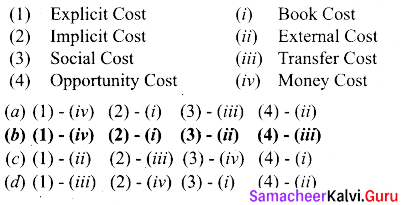
Answer:
(b) (1) – (iv), (2) – (1), (3) – (ii), (4) – (iii)
Question 9.
The concept of imperfect competition was propounded by _________.
(a) J.M. Keynes
(b) Irving Fisher
(c) Marshall
(d) Joan Robinson
Answer:
(d) Joan Robinson
Question 10.
Identify the wrong statement about the features of Duopoly.
(a) There is product differentiation.
(b) They fix the price for their product to maximise their profit.
(c) Each seller is fully aware of his rival’s motive and actions.
(d) Both sellers may collude regarding the sale of commodity.
Answer:
(a) There is product differentiation.
Question 11.
“Wages is a sum of money paid under contract by an employer to a worker for the services rendered.” – Who said this statement?
(a) Walker
(b) Marshall
(c) Ricardo
(d) Benham
Answer:
(d) Benham
Question 12.
The first Wi-Fi facility was provided by Indian Railways in
(a) Bengaluru
(b) Chennai
(c) Delhi
(d) Mumbai
Answer:
(a) Bengaluru
Question 13.
Density of population =
(a) Total population / land area of the region
(b) Total population / Employment
(c) Land area / Total population
(d) Land area / Employment
Answer:
(a) Total population / land area of the region
![]()
Question 14.
The oldest large scale industry in India is _______.
(a) Steel
(b) Cement
(c) Cotton
(d) Jute
Answer:
(c) Cotton
Question 15.
Twelfth Five Year Plan period ________.
(a) 2007-2012
(b) 1997-2002
(c) 2012-2017
(d) 2002-2007
Answer:
(c) 2012-2017
Question 16.
India is the largest producer of ______ in the world
(a) petrol
(b) diesel
(c) fruits
(d) gold
Answer:
(c) fruits
Question 17.
‘India lives in villages’, said by ________.
(a) V.K.R.V. Rao
(b) J.C. Kumarappa
(c) Mahatma Gandhi
(d) Jawaharlal Nehru
Answer:
(c) Mahatma Gandhi
Question 18.
______ are set up with a view to develop rural economy by providing credit and other facilities to small and marginal farmers.
(a) MUDRA Bank
(b) RRB
(c) SHG
(d) NABARD
Answer:
(b) RRB
![]()
Question 19.
Which of the following is wrongly matched?
(a) SAIL – Salem
(b) The Pump City – Coimbatore tax
(c) BHEL – Trichy
(d) Knitting City – Karur
Answer:
(d) Knitting City – Karur
Question 20.
The first person to apply mathematical method to economic problem was ________.
(a) G. Crammer
(b) Paul Samuelson
(c) Sir William Petty
(d) Giovanni Ceva
Answer:
(d) Giovanni Ceva
Part – II
Answer any seven questions in which question No. 30 is compulsory. [7 × 2 = 14]
Question 21.
Define Consumer’s Surplus according to Alfred Marshall.
Answer:
Alfred Marshall defines Consumer’s Surplus as “the excess of price which a person would be willing to pay a thing rather than go without the thing, over that which he actually does pay is the economic measure of this surplus satisfaction. This may be called consumers surplus”.
Question 22.
What is meant by Sunk Cost?
Answer:
A cost incurred in the past and cannot be recovered in future is called as Sunk Cost. This is historical but irrelevant for future business decisions. It is called as sunk because, they are unalterable, unrecoverable and if once invested it should be treated as drowned or disappeared.
Question 23.
What are the kinds of profit? Explain them.
Answer:
There are three kinds of profit:
- Monopoly Profit: Profit earned by the firm because of its monopoly control.
- Windfall Profit: Sometimes, profit arises due to changes in price level. Profit is due to unforeseen factors.
- Profit as functional reward: Just like rent, wage and interest, profit is earned by the entrepreneur for his entrepreneurial function.
![]()
Question 24.
What is NITI Aayog? What are its functions?
Answer:
- The Planning Commission has been replaced by the NITI Aayog on 1 st January, 2015.
- NITI (National Institution for Transforming India) Aayog will monitor, coordinate and ensure implementation of the accepted sustainable development goals.
- NITI Aayog serves as a knowledge hub and monitors progress in the implementation of policies and programmes of the Government of India.
- It includes the matters of national and international importance on the economic front, dissemination of best practices from within the .country and from other nations, the infusion of new policy ideas and specific issue-based support.
Question 25.
State any four features of developed economy.
Answer:
Features of a Developed Economy:
- High National Income
- High Per Capita Income
- High Standard of Living
- Full Employment of Resources
Question 26.
Define disinvestment.
Answer:
Disinvestment means selling of government securities of Public Sector Undertakings [PSUs] to other PSUs or Private Sectors or banks. This process has not been fully implemented.
Question 27.
Define Cottage Industry. State any two characteristics of cottage industries.
Answer:
Cottage industries are generally associated with agriculture and provide both part-time and full-time jobs in rural areas. Some important characteristics of cottage industries are:
- These industries are carried out by artisans in their own homes at their own risk and for their own benefit.
- No or little outside labour is employed. Normally, the members of the household provide the necessary labour.
Question 28.
What is crop insurance?
Answer:}
Agriculture in India is highly prone to risks like droughts and floods. It is necessary to protect the farmers from natural calamities and ensure their credit eligibility for the next season.
For this purpose, the Government of India introduced many agricultural schemes throughout the country. The Pradhan Mantri Fasal Bima Yojana (Prime Minister’s Crop Insurance Scheme) was launched on 18 February 2016.
![]()
Question 29.
Find the value of the determinant for the matrix A = \(\left(\begin{array}{cc}
3 & 4 \\
10 & -2
\end{array}\right)\)
Answer:
Given matrix A = \(\left(\begin{array}{cc}
3 & 4 \\
10 & -2
\end{array}\right)\) then, the department
|A| = \(\left|\begin{array}{ll}
3 & 4 \\
10 & -2
\end{array}\right|\) = 3(-2) – 10(4)
= – 6 – 40 = -46 is the value of the determinant.
Question 30.
Write short notes on mineral resources of Tamil Nadu.
Answer:
- Tamil Nadu has a few mining projects based on Titanium, Lignite, Magnesite, Graphite, Limestone, Granite and Bauxite.
- The first one is the Neyveli Lignite Corporation that has led development of large industrial complex around Neyveli in Cuddalore district with thermal power plants, Fertilizer and Carbonisation plants.
- Magnesite mining is at Salem from which mining of Bauxite ores are carried out at Yercaud and this region is also rich in Iron Ore at Kanjamalai. Molybdenum is found in Karadikuttam in Madurai district.
Part – III
Answer any seven questions in which question No. 40 is compulsory. [7 × 3 = 21]
Question 31.
What are the differences between micro-economics and macro-economics.
Answer:
Micro Economics:
- It is that branch of economics which deals with the economic decision making of individual economic agents such as the producer, the consumer etc.
- It takes into account small components of the whole economy
- It deals with the process of price determination in case of individual products and factors of production.
- It is known as price theory.
- It is concerned with the optimization goals of individual consumers and producers.
Macro Economics:
- It is that branch of economics which deals with aggregates and averages of the entire economy. E.g., aggregate output, national income, aggregate savings and investment, etc.
- It takes into consideration that economy of the country as a whole.
- It deals with general price-level in any economy.
- It is also known as the income theory.
- It is concerned with the optimization of the growth process of the entire economy.
![]()
Question 32.
Describe the features of human wants.
Answer:
(a) Wants are unlimited:
Human wants are countless in number and various in kinds. When one want is satisfied another want crops up. Human wants multiply with the growth of civilization and development.
(b) Wants become habits:
Wants become habits; for example, when a man starts reading news paper in the morning, it becomes a habit. Same is the case with drinking tea or chewing pans.
(c) Wants are Satiable:
Though we cannot satisfy all our wants, at the same time we can satisfy particular wants at a given time. When one feels hungry, he takes food and that want is satisfied.
(d) Wants are Alternative:
There are alternative ways to satisfy a particular want. E.g., Idly, dosa or chappathi.
(e) Wants are Competitive:
All our wants are not equally important. So, there is competition among wants. Hence, we have to choose more urgent wants than less urgent wants.
(f) Wants are Complementary:
Sometimes, satisfaction of a particular want requires the use of more than one commodity. Example: Car and Petrol, Ink and Pen.
(g) Wants are Recurring:
Some wants occur again and again. For example, if we feel hungry, we take food and satisfy out want. But after sometime, we again feel hungry and want food.
Question 33.
Find out the missing Marginal Product and Average Product for the given table.
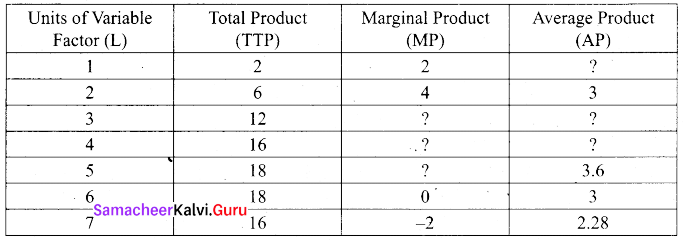
Answer:
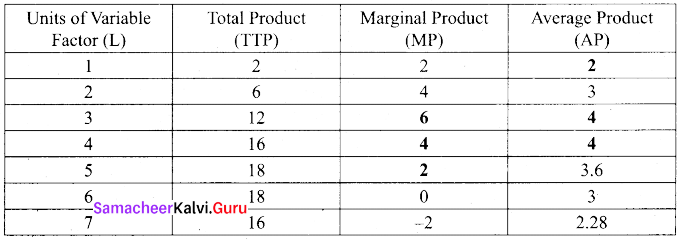
Question 34.
Define opportunity cost with an example.
Answer:
- Opportunity refers to the cost of next best alternative use. In other words, it is the value of the next best alternative foregone.
- For example, a farmer can cultivate both paddy and sugarcane in a farm land. If he cultivates paddy, the opportunity cost of paddy output is the amount of sugarcane output given up. Opportunity Cost is also called as ‘Alternative Cost’ or ‘Transfer Cost’.
![]()
Question 35.
What is Monopsony?
Answer:
Monopsony is a market structure in which there is only one buyer of a good or service. If there is only one customer for a certain good, that customer has monopsony power in the market for that good. Monopsony is analogous to monopoly, but monopsony has market power on the demand side rather than on the supply side.
Question 36.
What are the types of Natural resources?
Answer:
Water resources:
Tamil Nadu is not endowed with rich natural resources compared to other States. It accounts for three per cent of water sources, four per cent of land area against six per cent of population.
North East monsoon is the major source of rainfall followed by South West monsoon. There are 17 river basins in Tamil Nadu. The main rivers are Palar, Cheyyar, Ponnaiyar, Cauvery, Bhavani, Vaigai, Chittar, Tamiraparani, Vellar, Noyyal Siruvani, Gundar, Vaipar, Valparai, etc. Wells are the largest source of irrigation in Tamil Nadu (56%).
Mineral resources:
Tamil Nadu has a few mining projects based on Titanium, Lignite, Magnesite, Graphite, Limestone, Granite and Bauxite. The first one is the Neyveli Lignite Corporation that has led development of large industrial complex around Neyveli in Cuddalore district with thermal power plants, Fertilizer and Carbonisation plants.
Magnesite mining is at Salem from which mining of Bauxite ores are carried out at Yercaud and this region is also rich in Iron Ore at Kanjamalai. Molybdenum is found in Karadikuttam in Madurai district.
Question 37.
List out the objectives of MUDRA BANK.
Answer:
- Regulate the lender and the borrower of micro-finance and bring stability to the
micro-finance system. . - Extend finance and credit support to Micro-finance Institutions (MFI) and agencies that lend money to small businesses, retailers, self-help groups and individuals.
- Register all MFIs and introduce a system of performance rating and accreditation for the first time.
- Offer a Credit Guarantee scheme for providing guarantees to loans being offered to micro businesses.
- Introduce appropriate technologies to assist in the process of efficient lending, borrowing and monitoring of distributed capital.
Question 38.
Describe the development of Textile industry in Tamil Nadu.
Answer:
- Tamil Nadu is the largest textile hub of India.
- Tamil Nadu is known as the “Yam Bowl” of the country accounting for 41% of India’s cotton yam production.
- The textile industry plays a significant role in the Indian economy by providing direct employment to an estimated 35 million people, and thereby contributing 4% of GDP and 35% of gross export earnings.
- The textile sector contributes to 14% of the manufacturing sector.
- From spinning to garment manufacturing, entire textile production chain facilities are in Tamil Nadu.
- About half of India’s total spinning mill capacity is in Tamil Nadu.
- The western part of Tamil Nadu comprising Coimbatore, Tirupur, Erode, Dindigul and Karur has the majority of spinning mills manufacturing cotton, polyester, blended yam and silk yam used by garment units in Tamil Nadu, Maharastra etc.,
- Yam is also exported to China, Bangladesh, etc.,
- Tirupur known as “knifting city” is the exporter of garments worth USD (United States Dollar) 3 billion.
- Karur is the major home for textile manufacturing (curtain cloth, bed linens, kitchen linens, toilet linens, table linens, wall hangings etc.,) and export hub in India.
- Erode is the main cloth market in South India for both retail and wholesale ready-mades.
![]()
Question 39.
Solve for x quantity demanded if 16x – 4 = 68 + 7x.
Answer:
16x – 4 = 68 + 7x
16x – 7x = 68 + 4
9x = 72
x = \(\frac{72}{9}\)
x = 8
Question 40.
Differentiate between Rent and Quasi-Rent.
Answer:
Rent:
- Rent accrues to land
- The supply of land is fixed forever.
- It enters into price
Quasi – Rent:
- Quasi-Rent accrues to manmade appliances.
- The supply of manmade appliances is fixed for a short period only.
- It does not enter into price.
Part – IV
Answer all the questions. [7 × 5 = 35]
Question 41.
(a) Explain basic problems of the economy with the help of Production Possibility Curve.
Answer:
Production possibility curve shows the menu of choice along which a society can choose to substitute one good for another assuming a given state of technology and given total resources.
Assumptions:
- The time period does not change
- Techniques of production are fixed.
- There is full employment in the economy.
- Only two goods can be produced from the given resources
- Resources of production are fully mobile.

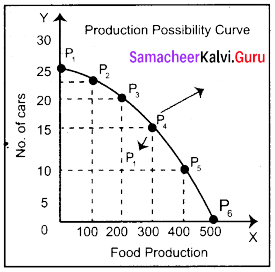
Explanation:
- The quantity of food is shown on x-axis and the number of cars is shown on y-axis.
- The different six production possibilities are being shown as point P1 P2 P3 P4 P5 & P6.
- A maximum of 500 tons of food can be produced, given the existing technology.
- If on the other hand, all resources are instead used for producing cars, 25 cars can be produced.
- In between these two extremes, possibilities exist.
- If we are willing to give up some food, we can have some cars.
[OR]
(b) Explain the public transport system in Tamil Nadu.
Answer:
Tamil Nadu has a well established transportation system that connects all parts of the State. This is partly responsible for the investment in the State. Tamil Nadu is served by an extensive road network in terms of its spread and quality, providing links between urban centres, agricultural market-places and rural habitations in the countryside. However, there is scope for improvement.
(a) Road Transport:
- There are 28 national highways in the State covering a total distance of 5,036 km.
- The State has a total road length of 167,000 km, of which 60,628 km are maintained by Highways Department.
(b) Rail Transport:
- Tamil Nadu has a well-developed rail network as part of Southern Railway, Headquartered at Chennai.
- Tamil Nadu has a total railway track length of 6,693 km and there are 690 railway stations in the State.
- Main rail junctions in the State include Chennai, Coimbatore, Erode, Madurai, Salem, Tiruchirapalli and Tirunelveli.
- Chennai has a well-established, suburban Railway network, a Mass Rapid Transport system and is currently developing a Metro System, with its first underground stretch operational since May 2017.
(c) Air Transport:
- Tamil Nadu has four major international airports.
- Chennai International Airport is currently the third largest airport in India.
- Other international Airports in Tamil Nadu include Coimbatore International Airports, Madurai International Airport and Tiruchirapalli International Airport.
- It also has domestic airports at Tuticorin, Salem, and Madurai.
- Increased industrial activity has given rise to an increase in passenger traffic as well as freight movement which has been growing at over 18% per year.
(d) Ports:
- Tamil Nadu has three major ports; one each at Chennai, Ennore and Tuticorin, as well as one intermediate port in Nagapattinam, and 23 minor ports.
- The ports are currently capable of handling over 73 million metric tonnes of cargo annually (24 % share of India).
- All the minor ports are managed by the Tamil Nadu Maritime Board, Chennai Port.
- This is an artificial harbour and the second principal port in the country for handling containers.
- It is currently being upgraded to have a dedicated terminal for cars capable of handling 4,00,000 vehicles.
- Ennore port was recently converted from an intermediate port to a major port and handles all the coal and ore traffic in Tamil Nadu.
![]()
Question 42.
(a) Explain the law of demand with a diagram.
Answer:
Definition:
According to Alfred Marshall, the Law of Demand said as “the quantity demanded increases with a fall in price and diminishes with a rise in price”.
Assumptions of Law of Demand:
- The income of the consumer remain constant.
- The taste, habit and preference of the consumer remain the same.
- The prices of other related goods should not change.
- There should be no substitutes for the commodity in study.
| Price | Quantity Demanded |
| 5 | 1 |
| 4 | 2 |
| 3 | 3 |
| 2 | 4 |
| 1 | 5 |
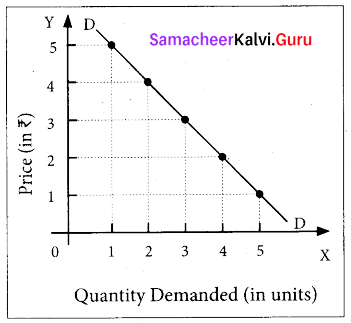
Explanation:
- Quantity demanded and Y axis represents the price of the commodity.
- DD is the demand curve, which has a negative slope.
- Slope downward from left to right which indicates that when price falls, the demand expands and when price rises, the demand contracts.
Conclusion:
Therefore, the law of demand states that there is an inverse relationship between the price and the quantity demanded of a commodity.
[OR]
(b) Illustrate the Ricardian theory of Rent.
Answer:
Definition:
According to Ricardo, “Rent is the that portion of the produce of the earth which is paid to the landlord for the use of the original and indestructible powers of the soil”.
Assumptions:
- Land differs in fertility.
- The law of diminishing returns operates in agriculture.
- Rent depends upon fertility and location of land.
- Theory assumes perfect competition.
Schedule of Ricardian Theory of Rent:
| Grades of Lands | Production (in bags) | Surplus (i.e., Rent in bags) |
| A | 40 | 40 – 20 = 20 |
| B | 30 | 30 – 20 = 10 |
| C | 20 | 20 – 20 = 0 |

Explanation:
- In diagram, X axis represents various grades of land and Y axis represents yield per acre (in bags).
- 0A, AB and BC are the ‘A’ Grade, ‘B’ grade and ‘C’ grade lands respectively.
- The application of equal amount of labour and capital on each of them gives a yield represented by the rectangles standing just about the respective bases.
- The ‘C’ grade land is the ‘no-rent land’ “A” and “B” grade lands are “intra – marginal lands”.
Question 43.
(a) Describe the properties of Iso – quants with the help of diagrams.
Answer:
Properties of Iso-quant Curve:
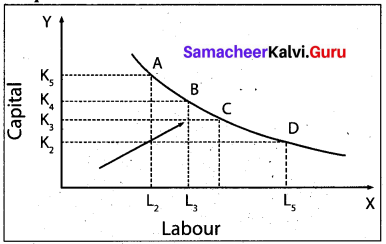
1. The iso-quant curve has negative slope.
It slopes downwards from left to right indicating that the factors are substitutable. If more of one factor is used, less of the other factor is needed for producing the same level of output. In the diagram combination A refers to more of capital K5 and less of labour L2. As the producer moves to B, C, and D, more labour and less capital are used.
2. Convex to the origin.
This explains the concept of diminishing Marginal Rate of Technical Substitution (MRTSLK). For example, the capital substituted by 1 unit of labour goes on decreasing when moved from top to bottom. If so, it is called diminishing MRTS. Constant MRTS (straight line) and increasing MRTS (concave) are also possible. It depends on the nature of iso-quant curve.
This means that factors of production are substitutable to each other. The capital substituted per unit of labour goes on decreasing when the iso-quant is convex to the origin.
Marginal Rate of technical substitution
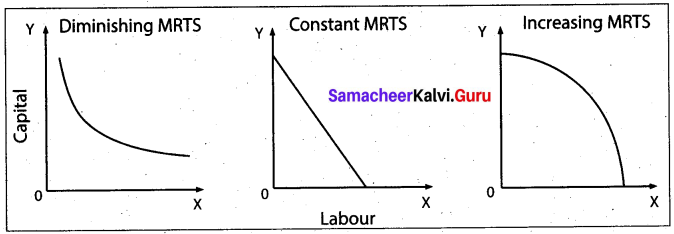
3. Non inter-section of Iso-quant curves.
For instance, point A lie on the isoquants IQ1 and IQ2. But the point C shows a higher output and the point B shows a lower level of output IQ1.
If C = A, B = A, then C = B. But C > B which is illogical.
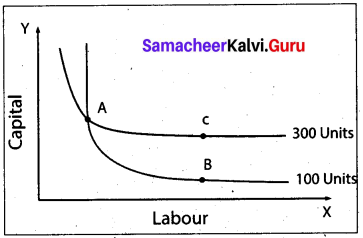
4. An upper iso-quant curve represents a higher level of output.
Higher IQs show higher outputs and lower IQs show lower outputs, for upper iso-quant curve implies the use of more factors than the lower isoquant curve.
The arrow in the figure shows an increase in the output with a right and upward shift of an iso-quant curve.
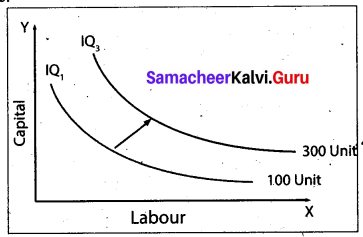
5. Iso-quant curve does not touch either X axis or Y axis.
No iso-quant curve touches the X axis or Y axis because in IQ1 only capital is used, and in IQ2 only labour is used.
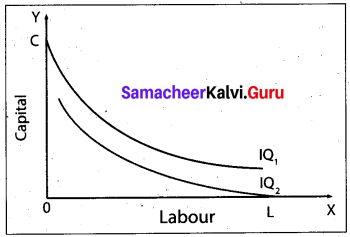
[OR]
(b) Explain about the Industry clusters in Tamil Nadu
Answer:
- Chennai is sometimes referred to as the Health Capital of India or the Banking Capital of India, having attracted investments from International Finance Corporations and the World Bank. It is also called as Detroit of Asia.
- Tamil Nadu has a network of about 110 industrial parks / estates that offer developed plots with supporting infrastructure.
- Also, the Government is promoting other industrial parks like Rubber Park, Apparel Park, Floriculture Park, TICEL Park for Biotechnology, Siruseri IT Park and Agro Export Zones.
- The heavy engineering manufacturing companies are Centred around the subrubs of Chennai. Chennai boasts of global car manufacturing giants as well as home grown companies.
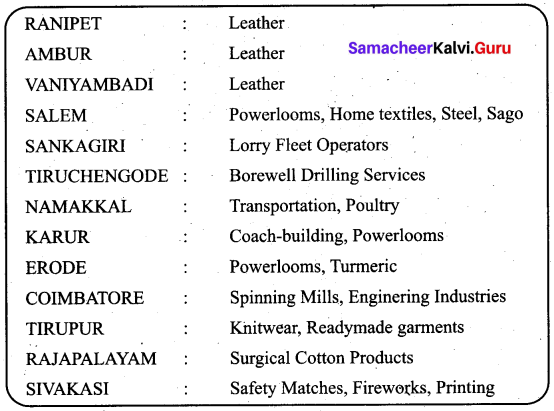
- Karur is known for its bus body building which contributes 80% of South Indian bus body building.
- TNPL is the Asia’s largest ecofriendly paper mill. Salem is called as steel city and has many sago producing units and mineral wealth.
- Sivakasi is the leader in printing, fireworks, safety matches production in India. It contributes to 80% of India’s total safety matches production and 90% of India’s total fireworks production.
- Thoothukudi is the gateway of Tamil Nadu. It is a major chemical producer next only to Chennai.
![]()
Question 44.
(a) Bring out the relationship between AR and MR curves under various price conditions.
Answer:
If a firm is able to sell additional units at the same price then AR and MR will be constant and equal. If the firm is able to sell additional units only by reducing the price, then both AR and MR will fall and be different.
Constant AR and MR (at Fixed Price):
When price remains constant or fixed, the MR will be also constant and will coincide with AR. Under perfect competition as the price is uniform and fixed, AR is equal to MR and their shape will be a straight line horizontal to X axis. The AR and MR Schedule under constant price is given in the below table and in the diagram.
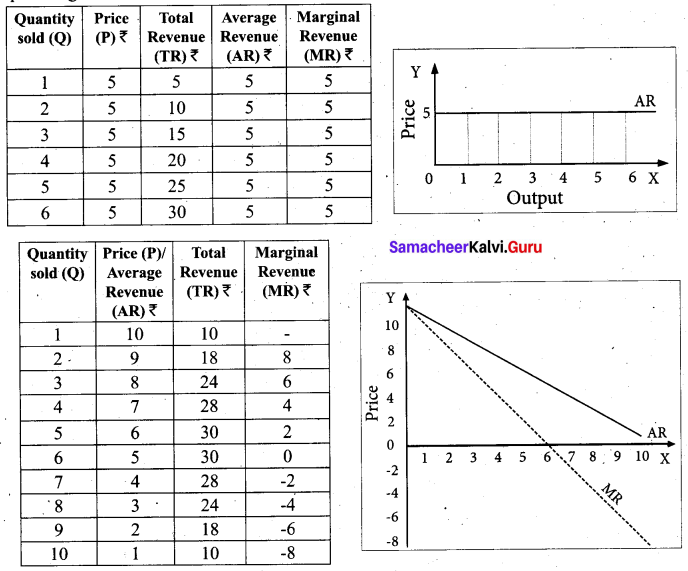
Declining AR and MR (at Declining Price):
When a firm sells large quantities at lower prices both AR and MR will fall but the fall in MR will be more steeper than the fall in the AR.
It is to be noted that MR will be lower than AR. Both AR and MR will be sloping downwards straight from left to right. The MR curve divides the distance between AR Curve and Y axis into two equal parts. The decline in AR need not be a straight line or linear. If the prices are declining with the increase in quantity sold, the AR can be non-linear, taking a shape of concave or convex to the origin.
[OR]
(b) If the demand function is P = 35 – 2x – x2 and the demand x0 is 3, what will be the consumer’s surplus?
Answer:
Given demand function,
P = 35 – 2x – x2 For x = 3
P = 35 – 2(3) – 32
= 35 – 6 – 9.
P = 20 Therefore,
CS = (Area of the curve below the demand curve from 0 to 3) – Area of the rectangle (20 x – = 60)
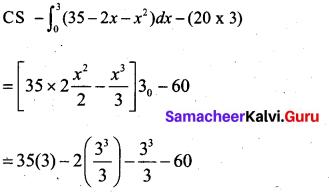
= 105 – 9 – 9 – 60 = 27 Units
Question 45.
(a) Explain the features of Oligopoly.
Answer:
- Few large firms: Very few big firms own the major control of the whole market by producing major portion of the market demand.
- Interdependence among firms: The price and quality decisions of a particular firm are dependent on the price and quality decisions of the rival firms.
- Group behaviour: The firms under oligopoly relalise the importance of mutual cooperation.
- Advertisment cost: The oligopolist could raise sales either by advertising or improving the quality of the product.
- Nature of product: The oligopoly means homogeneous products and imperfect oligopoly deals with- heterogeneous products.
- Price rigidity: It implies that prices are difficult to be changed. The oligopolistic firms do not-change their prices due to the fear of rivals’ reaction.
[OR]
(b) Write a brief note on the Gandhian economic ideas.
Answer:
1. Village Republics:
To Gandhi, India lives in villages. He was interestred in developing the villages j as self sufficient units. He opposed extensive use of machinery, urbanization and industrialization.
2. On Machinery:
Gandhi described machinery as “Great Sin’. He said that “Books could be written to demonstrate the evils it is necessary to realize that machinery is bad. Instead of welcoming machinery as a boon, we should look upon it as an evil. It would ultimately crease.
3. Industrialism:
Gandhi considered industrialism as a curse on mankind. He thought industrialism depended entirely on a country’s capacity to exploit.
4. Decentralization:
He advocated a decentralized economy, i.e., production at a large number of places on a small scale or production in the people’s homes.
5. Villge Sarvodaya:
According to Gandhi, “Real India was to be found in villages and not in towns or cities. So he suggested the development of self sufficient, self-dependent villages.
6. Bread Labour:
Gandhi realized the dignity of human labour. He believed that God created man to eat his bread by sweat of his brow. Bread labour or body labour was the expression that Gandhi used to mean manual labour.
7. The Dcotrine of Trusteeship:
Trusteeship provides a means of transforming the present capitalist order of society into an egalitarian one. It gives no quarter to capitalism. However, now India experiences * S both casino capitalism and crony capitalsm.
8. On the Food Problem:
Gandhi was against any sort of food controls. He thought Such controls only created artificial scarcity. Once India was begging for food grain, but India tops the world with very large production of foodgrains, fruits, vegetables, milk, egg, meat etc.
9. On population:
Gandhi opposed the method of population control through contraceptives. He was, however, in favour of birth control as a sovereign remedy to the problem of over population.
10. On Prohibition:
Gandhi advocated cent per cent prohibition. He regarded the use of liquor as a disease rather than a vice. He felt that it was better for India to be poor than to have thousands of drunkards. But, now many states depend on revenue from liquor sales.
![]()
Question 46.
(a) Explain the objectives of nationalization of commercial banks.
Answer:
The Government of India nationalized the commercial banks to achieve the following objectives:
- The main objective of nationalization was to attain Social Welfare. Sectors such as agriculture, small and village industries were in need of funds for their expansion and further economic development.
- Nationalisation of banks helped to curb private monopolies in order to ensure a smooth supply of credit to socially desirable sections.
- In India, nearly 70% of population lived in rural areas. Therefore it was needed to encourage the banking habit among the rural population.
- Nationalisation of banks was required to reduce the regional imbalances where the banking facilities were not available.
- Before Independence, the numbers of banks were certainly inadequate. After nationalization, new bank branches were opened in both rural and urban areas.
- Banks created credit facilities mainly to the agriculture sector and its allied activities after nationalization.
After New Economic Policy 1991, the Indian banking Industry has been facing the new horizons of competitions, efficiency and productivity.
[OR]
(b) How are the information and communication technologies (ICT) used in economics?
Answer:
Information and Communication Technology (ICT) is the infrastructure that enables computing faster and accurate. The following table gives an idea of range of technologies that fall under the category of ICT.
| Information | Technologies |
| Creation | Personal Computer, Digital Camera, Scanner, Smart Phone. |
| Processing | Calculation, PC, Smart Phone |
| Storage | CD, DVD, Pen Drive, Microchip, Cloud |
| Display | PC, TV, Projector, Smart Phone |
| Transmission | Internet, Teleconference, Video Conferencing, Mobile Technology, Radio |
| Exchange | E-mail, Cell phone |
THE EVALUATION OF ICT HAS FIVE PHASES.
They are evolution in
- Computer
- PC
- Microprocessor
- Internet and
- Wireless links
In Economics, the uses of mathematical and statistical tools need the support of ICT for data compiling, editing, manipulating and presenting the results. In general, SPSS and Excel packages are often used by researchers in economics. Such Software is designed to do certain user tasks. Word process, spread sheet and web browser are some of the examples which are frequently used while undertaking analysis in the study of economics.
![]()
Question 47.
(a) Explain the objectives and characteristics of Special Economic Zones (SEZ).
Answer:
- The Special Economic Zones [SEZs] Policy was announced in April 2000.
- The Special Economic Zones Act of 2005, the government has so far notified about 400 such zones in the country.
Major objectives of SEZs:
- To enhance foreign investment, especially to attract foreign direct investment [FDI] and thereby increasing GDP.
- To increase shares in Global Export. (International Business)
- To generate additional economic activity.
- To create employment opportunities.
- To develop infrastructure facilities.
- To exchange technology in the global market.
Main Characteristics of SEZ:
- Geographically demarked area with physical security.
- Administrated by single body authority.
- Streamlined procedures.
- Having separate custom area.
- Governed by more liberal economic laws.
- Greater freedom to the firms located in SEZs. .
[OR]
(b) Analyse the causes for Rural Indebtedness.
Answer:
The causes for rural indebtedness may be summarized as below:
- Poverty of Farmers: The vicious circle of poverty forces the farmers to borrow for consumption, cultiviation and celebrations., Thus, poverty, debt and high rates of interest hold the farmer in the grip of money lenders.
- Failure of Monsoon: Frequent failure of monsoon is a curse to the farmers and they have to suffer due to the failure of nature. Therefore, farmers find it difficult to identify good years to repay their debts.
- Litigation: Due to land disputes litigation in the court compels them to borrow heavily. Being uneducated and ignorant they are caught in the litigation process and dry away their savings and resources.
- Money Lenders and High Rates of Interest: The rate of interest charged by the local money lenders is very high and the compounding of interest leads to perpetuate indebtedness of the farmer.